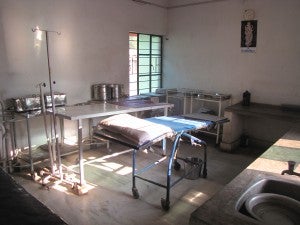 We typically think of genitourinary fistula as tragic birth injury, resulting from the death of soft tissue during obstructed labor without timely medical intervention. Most fistulas are indeed obstetric, but a recently published article by Dr. Thomas Raassen and others found that over 13% of women presenting for fistula repair surgery suffered because of accidents caused by health providers. Such injuries are known as iatrogenic fistulas.
We typically think of genitourinary fistula as tragic birth injury, resulting from the death of soft tissue during obstructed labor without timely medical intervention. Most fistulas are indeed obstetric, but a recently published article by Dr. Thomas Raassen and others found that over 13% of women presenting for fistula repair surgery suffered because of accidents caused by health providers. Such injuries are known as iatrogenic fistulas.
Any surgery carries some risk of provider error. Health workers can inadvertently cause iatrogenic fistula during cesarean sections, hysterectomies, and other obstetric or gynecological surgeries, particularly when working in difficult environments with limited staffing, infrastructure, clinical training, and supervision. Any injury occurring in a facility should be considered a sentinel event, pointing to issues surrounding the quality of care. This is particularly true of injuries during labor and delivery, where an otherwise healthy woman is undergoing medical intervention for what should be a natural life event.
Raassen et al.’s retrospective record review—the largest study of its kind, looking at 805 iatrogenic fistulas over 18 years—addresses gaps in the world’s understanding of iatrogenic fistula, presenting its classifications, causes, and risk factors.
The study found that 80% of iatrogenic fistulas occur in women who had emergency obstetric surgery, often to address difficult labor or a ruptured uterus. One quarter of the women with iatrogenic fistulas had previously delivered once or several times by cesarean section, suggesting that women who undergo multiple abdominal surgeries are at heightened risk for iatrogenic fistula during a subsequent surgery.
Prevention of iatrogenic fistula is an urgent matter. Providers must have the knowledge and experience to be able to provide high-quality obstetric and gynecological surgery. Training, combined with mentoring and ongoing supervision, is essential. Providers may benefit from training on alternatives to cesarean section, for example craniotomy of fetuses that die during obstructed labor. Provider training should likewise highlight optimal operative techniques.
A reassessment of training content and current clinical practice may be needed in countries where women suffer from fistula or where emergency obstetric care is being rapidly scaled-up, especially without adequate quality assurance mechanisms. Such activities could ensure that the increasing numbers of facility-based delivery will be associated with declines — rather than increases — in maternal morbidities.
Correction to article: We would like to note an error in the published version of the article by Raassen et al. on iatrogenic fistula. The authors use the Waaldijk classification system to describe the location of three types of iatrogenic fistula. Vesico-[utero]/-cervico-vaginal fistulas (VCVF) and vault fistulas are Waaldijk Type I, since they do not involve the closing mechanism of the bladder. Type II fistulas involve the closing mechanism of the bladder and are obstetric in origin. Ureteric fistulas are Waaldijk Type III: exceptional fistulas. Table 2 in the published paper erroneously labels vault fistulas as Type II rather than a subgroup of Type I. No Type II fistulas are reported in Table 2. We regret this error, which may cause readers to misunderstand the categories of iatrogenic fistula.
